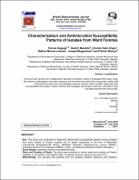| dc.description.abstract | Aim: The study was conducted to determine antimicrobial susceptibility patterns among isolates
from ward fomites at Kiwoko Hospital and to detect resistances in the form of Macrolide
Lincosamide StreptograminB (MLSB), Methicillin Resistant Staphylococcus aureus (MRSA),
Extended Spectrum β Lactamases (ESBLs), AmpC, and Multi Drug Resistant (MDR) pathogens.
Study Design: Laboratory based cross-sectional study.
Place and Duration of Study: The study was conducted in various wards and sections at Kiwoko
Hospital, a rural setting in the central region of Uganda, between January and June 2015.
Methodology: We recruited 290 samples from the Surgical, Medical, Maternity and Pediatricwards as well as the Out Patient Department (OPD) at Kiwoko Hospital for the study. Samples
were taken by swabbing the different surfaces and instruments which included;
sphygmomanometers, stethoscopes, beds, nurses’ stations, staff/visitors’ chairs, door handles,
patients’ crepe bandages, curtains, switches, and sink handles among others. Susceptibility testing
was done using the disc diffusion methods by Kirby Bauer for phenotypic expression of MLSB
resistances, MRSA, MSSA, ESBL, MDR and AmpC. Co-resistances exhibited by isolated ESBL
producers were also phenotypically tested.
Results: Of the 290 surfaces and instruments swabbed, 57.59% (CI= 49.18 - 67.01) carried
bacterial pathogens and by using standard surface agar plating methods, Staphylococcus aureus
was the mostly isolated pathogen 43 (25.75%), followed by Klebsiella pneumoniae 35 (20.96%),
Escherichia coli 31 (18.55%), Pseudomonas aeruginosa 20 (11.98%), Enterococcus faecalis 12
(7.19%), Staphylococcus epidermidis 10 (5.98%), Proteus mirabilis 9 (5.39%), Bacillus spp. 4
(2.40%), and Staphylococcus saprophyticus 3 (1.80%). Among enterobacteriaceae, 5 (6.67%, CI=
2.16 – 15.56) were identified as AmpC producers and 16 (21.33%, CI= 12.19 - 34.64) as ESBL
producers out of which 4/16 (25.00%, CI = 6.81 – 64.01) showed ESBL co-resistance. Of the 43
Staphylococcus aureus isolates, 9.30% were MRSA (CI = 2.53 - 23.82) and 90.70% MSSA (CI =
64.49 - 100). In MLSB resistance patterns, 23.26% of the total S. aureus isolates were constitutive
MLSB while 6.98% showed inducible MLSB as 27.91% exhibited an MS phenotype. Out of all the
isolates recovered from fomites, 27/167 (16.17%, CI = 10.65 – 23.52) were identified as Multi Drug
Resistant (MDR).
Conclusion: Hospital fomites harbored resistant pathogens that could well persist for a long period
of time thereby predisposing patients to Hospital acquired infections. Therefore, routine screening
of clinical samples for MLSB, ESBL, AmpC, MRSA and MDR could significantly monitor potential
treatment failures in the management of resistant bacterial infections spread by pathogens on ward
items and surfaces at Kiwoko Hospital, Uganda. | en_US |

